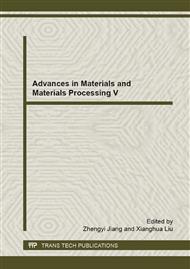[1]
Sidibė, K., Duprat, F., and Booureet, B., Fire Safety of Reinforced Concrete Columns, Journal of Structural Engineering, ASCE, 128(3), (2000), pp.365-373.
Google Scholar
[2]
J. C. Dotreppe, J. M. Fransen, A., Bruls, R. Baus, P., Vandervelde, R., Minnes, van D. Meurvenburg, and H. Lambette, Experimental Research on the Determination of Main Parameters Affecting the Behaviour of Reinforced Concrete Columns under Fire Conditions, Jour. Magazine of Concrete Research, 49 (179) (1997).
DOI: 10.1680/macr.1997.49.179.117
Google Scholar
[3]
C. -M. Aldea, J. -M. Franssen, and J. -C. Dotreppe, Fire Tests on Normal and High Strength Reinforced Concrete Columns, Fire Performance of High Strength Concrete, Proceedings of an International Workshop, NIST-National Institute of Standards and Technology, Gaithersburg, MD (1997).
DOI: 10.6028/nist.sp.919
Google Scholar
[4]
V.R. Kodur, and R. McGrath, Fire Endurance of High Strength Concrete Columns, Fire Technology, 39(1) (2003), pp.73-87.
Google Scholar
[5]
Sullivan, P. J. E., Terro, M. J., and Morris, W. A., Critical Review of Fire-dedicated Thermal and Structural Computer Programs, Journal of Applied Fire Science, 3(2) (1993) , pp.113-135.
DOI: 10.2190/41hq-kpc9-4jt5-vu5v
Google Scholar
[6]
Lie T.T. and Irwin R.J., Method to Calculate the Fire Resistance of Reinforced Concrete Columns with Rectangular Cross Section, ACI Structural Journal, 90(1) (1993), p.52–60.
DOI: 10.14359/4210
Google Scholar
[7]
Kodur V.R., Lie T.T., A Computer Program to Calculate the Fire Resistance of Rectangular Reinforced Concrete Columns, Third Canadian Conference on Computing in Civil and Building Engineering, Ottawa, Canada (1996), p.11–20.
Google Scholar
[8]
Terro M.J., Numerical Modeling of the Behavior of Concrete Structures in Fire, ACI Structural Journal, 95(3/4) (1998), p.183–193.
Google Scholar
[9]
Daniel Di Capua, and Antonio R. Mari, Nonlinear Analysis of Reinforced Concrete Cross-sections eExposed to Fire, Fire Safety Journal, 42(2007), p.139–149.
DOI: 10.1016/j.firesaf.2006.08.009
Google Scholar
[10]
Bazant Z.P. and Kaplan M.F., Concrete at High Temperature: Material Properties and Mathematical Models, Longman Group Limited (1996), London.
Google Scholar
[11]
Luccioni B.M., Figueroa M.I., and Danesi R.F., Thermo-mechanic Model for Concrete Exposed to Elevated Temperatures, Eng Structure, 25(2003), p.729–742.
DOI: 10.1016/s0141-0296(02)00209-2
Google Scholar
[12]
Terro MJ, Numerical Modeling of the Behavior of Concrete Structures in Fire, ACI Struct. J, 95(2) (1998), p.183–93.
Google Scholar
[13]
Lie T.T. (1992) , Structural fire protection, New York: American Society of Civil Engineers.
Google Scholar
[14]
A. Cengel Yunus, Heat transfer-A Practical Approach, McGraw-Hill, (2003).
Google Scholar
[15]
Z. Huang and A. Platten, Non-linear finite Element aAnalysis of Planar Reinforced Concrete Members Subjected to Fires, ACI Structural Journal, 94(3) (1997), p.272–282.
DOI: 10.14359/479
Google Scholar


